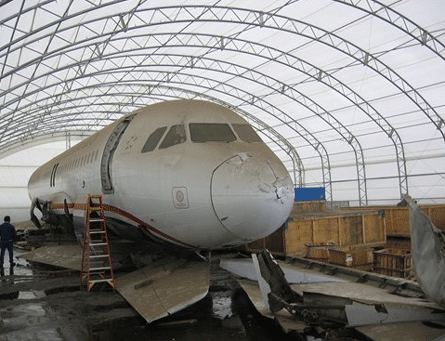An otherwise incidental trip to a Japanese museum planted the seeds for what will be the final home for the "Miracle on the Hudson" Airbus A320. N106US - flying as US Airways 1549 - was expertly piloted by Chesley Sullenberger to a safe splashdown in New York's Hudson river after losing power when it struck a flock of Canada geese after departure from LaGuardia airport on 15 January 2009. In May, the twinjet will slowly make its way to the Carolinas Aviation Museum in Charlotte, North Carolina - via six trucks.
A year ago, fate combined with a stroke of luck to set in train the aircraft's move to Charlotte from temporary shelter at the J Supor & Son facility in New Jersey.
In January, the facility's president Shawn Dorsch happened to be touring Japan Airlines' Safety Promotion Centre near Haneda airport. This opened in 2006 as a memorial to JAL Flight 123, a Boeing 747 that crashed into Japan's Mount Osutaka in 1985, killing 520 passengers and crew.
One portion of the JAL 123 display features the pressure bulkhead that ruptured and ultimately left the jumbo jet's pilots with no control over the vehicle. The second part is a room that Dorsch says has "a gigantic flow chart" on the wall showing all safety improvements made to commercial airliners since the crash.
 |
|---|
| More images on AirSpace |
"It terminates with 1549," says Dorsch. Those safety improvements are, he says, part of the reason why everyone on 1549 survived. "When I saw this, I realised that 1549 was an international aviation icon. For me, having it in the museum would give the opportunity to tell something much bigger than the event itself."
INSURANCE HELP
Aiding Dorsch in his new quest was that the insurance company that owned the hulk, Chartis, had been unsuccessful in an attempt to auction the airframe in January 2010. "We contacted Doug Parker, chief executive of US Airways," Dorsch says. "Through the efforts of US Airways and discussions with Chartis, the auction never took place."
Afterward there was an "unofficial" competition among the Carolina museum and two others for the aircraft. Dorsch believes the deciding factor in his favour was that Flight 1549 had been destined for US Airways' hub in Charlotte, also the museum's home.
He will not discuss the terms of the donation, which was concluded several months ago. "Chartis was very generous, and had great foresight in making the deal," he says.
The museum has hired international design firm Freeman Ryan to create the exhibit, which will include practically everything recovered from the aircraft, including the Coca-Cola cans in the service carts. "It's a time capsule," says Dorsch. "All of the [National Transportation Safety Board] markings and drawings on the outside of the aircraft are there. This is the first time anyone has attempted to preserve an airliner involved in an incident like this."
He says the museum is also working to obtain the engines, components not owned by Chartis. Rather than dwell on the event itself, Dorsch says the exhibit will "focus much more on the fact that aviation is a highly evolved system".
Support for the project has been immense, he reports. Airbus engineers are helping plan the move and design the support structures for the exhibit with engineering students from the University of North Carolina at Charlotte, and even the airline is on board.
"There's been a tremendous outpouring of support from US Airways," Dorsch says. He expects museum visitors to increase fivefold, to 100,000 a year, once the exhibit is completed in 2012.
Source: Flight International



















